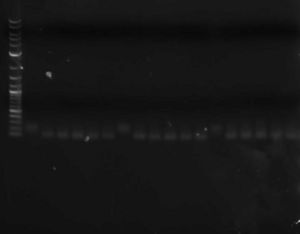Abstract
This is a consensus protocol. This protocol describes cloning into linearized plasmid vectors and subsequent transformation. Ligation (the joining together of two bits of DNA) involves creating a phosphodiester bond between the 3′ hydroxyl of one nucleotide and the 5′ phosphate of another. T4 DNA ligase is used to join the DNA fragments. This enzyme will ligate DNA fragments having blunt or overhanging, cohesive, ‘sticky’ ends.
DNA ligase is used to create a phosphodiester bond between the 5′ phosphate and 3′ hydroxyl groups of DNA. Most commonly, one needs to insert a DNA sequence of interest into a plasmid, ready for transformation into competent cells. Ideally, DNA and vector are individually cut with the same restriction enzyme, then both are added to a ligation reaction to be circularised by DNA ligase. T4 DNA ligase is the most commonly used DNA ligase for molecular biology techniques.
The two components of the DNA in the ligation reaction should be equimolar and around 100ug/ml. If the plasmid vector to target DNA ratio is too high then excess ’empty’ mono and polymeric plasmids will be generated. If too low then the result may be an excess of linear and circular homo- and heteropolymers.
Most commonly, following ligation the circularised plasmid, now containing your insert DNA, is transformed into competent bacteria for further selection and analysis. In bacteria, transformation refers to a genetic change brought about by taking up and expressing DNA i.e. your plasmid construct, and competence refers to the state of being able to take up DNA; most bacteria are not naturally transformable, but are made permeable to the plasmid DNA by chemical or electrochemical means. Competent cells are extremely fragile and should be handled gently, specifically kept cold and not vortexed. The transformation procedure is efficient enough for most lab purposes, with efficiencies as high as 109 transformed cells per microgram of DNA, but it is important to realize that even with high efficiency cells only 1 DNA molecule in about 10,000 is successfully transformed.
During “transformation,” a single plasmid from the ligation mixture enters a single bacterium and, once inside, replicates and expresses the genes it encodes. One of the genes on the pCX-NNX plasmid leads to ampicillin-resistance. Thus, a transformed bacterium will grow on agar medium containing ampicillin. Untransformed cells will die before they can form a colony on the agar surface.
Materials
Reagents
- T4 DNA Ligase
- 10x T4 DNA Ligase Buffer
- Deionized, sterile H2O
- Purified, linearized vector (likely in H2O or EB)
- Purified, linearized insert (likely in H2O or EB)
Equipment
Vortex
Protocol腌
10μl Ligation Mix
Larger ligation mixes are also commonly used
- 1.0 μL 10X T4 ligase buffer
- 6:1 Molar ratio of insert to vector (~10ng vector)
- Add (8.5 – vector and insert volume)μl ddH2O
- 0.5 μL T4 Ligase
Calculating Insert Amount
[math]\displaystyle{ {Insert\ Mass\ in\ ng} = 6\times\left[\frac{{Insert\ Length\ in\ bp}}{{Vector\ Length\ in\ bp}}\right]\times{Vector\ Mass\ in\ ng} }[/math]
This differs from the Knight calculation, not sure why, but it may be important.
Method
- Add appropriate amount of deionized H2O to sterile 0.6 mL tube
- Add 1 μL ligation buffer to the tube.
Vortex buffer before pipetting to ensure that it is well-mixed.
Remember that the buffer contains ATP so repeated freeze, thaw cycles can degrade the ATP thereby decreasing the efficiency of ligation.
- Add appropriate amount of insert to the tube.
- Add appropriate amount of vector to the tube.
- Add 0.5 μL ligase.
Vortex ligase before pipetting to ensure that it is well-mixed.
Also, the ligase, like most enzymes, is in some percentage of glycerol which tends to stick to the sides of your tip. To ensure you add only 1 μL, just touch your tip to the surface of the liquid when pipetting.
- Let the 10 μL solution sit at 22.5°C for 30 mins
- Denature the ligase at 65°C for 10min
- Dialyze for 20 minutes if electroporating
- Use disks shiny side up
- Store at -20°C
Critical steps
Troubleshooting
Notes
- Make sure the buffer is completely melted and dissolved. Precipitate is DTT (or BSA?). Probably best to aliquot this buffer into smaller portions, to reduce the freeze/thaw cycles. In general, make sure the buffer still smells strongly like “wet dog” (Checking if the DTT is still good.)
- If you are having trouble with your ligation, NEB offers FAQ’s (Quick Ligation T4 DNA ligase) to help.
- Prior to the ligation, some heat their DNA slightly (maybe ~37°C) to melt any sticky ends which may have annealed improperly at low temperatures.
- Tom Knight has read that ligase can inhibit transformation. By heat-inactivating the ligase, this inhibition can be avoided. However, according to the NEB FAQ, heat-inactivation of PEG (which is present in the ligation reaction) also inhibits transformation, therefore a spin-column purification is recommended prior to transformation if you are having problems.
- Treating PCR products with proteinase K prior to restriction digest dramatically improves the efficiency of subsequent ligation reactions. [1]
Acknowledgments
This consensus protocol was the first one I tried to put together. I realise it is not perfect but hope it gives you an idea of what I am trying to suggest. It was pretty much copied from Endy:DNA ligation using T4 DNA ligase, thanks Endy group and please accept my apologies if they are needed!
References
- Crowe JS, Cooper HJ, Smith MA, Sims MJ, Parker D, and Gewert D. Improved cloning efficiency of polymerase chain reaction (PCR) products after proteinase K digestion. Nucleic Acids Res. 1991 Jan 11;19(1):184. DOI:10.1093/nar/19.1.184 | PubMed ID:2011503 | HubMed [Crowe-NAR-1991]




 Three libraries ~100bp; on the left is the single-stranded oligo; on the right are double-stranded oligos (different lanes are different primers)
Three libraries ~100bp; on the left is the single-stranded oligo; on the right are double-stranded oligos (different lanes are different primers)